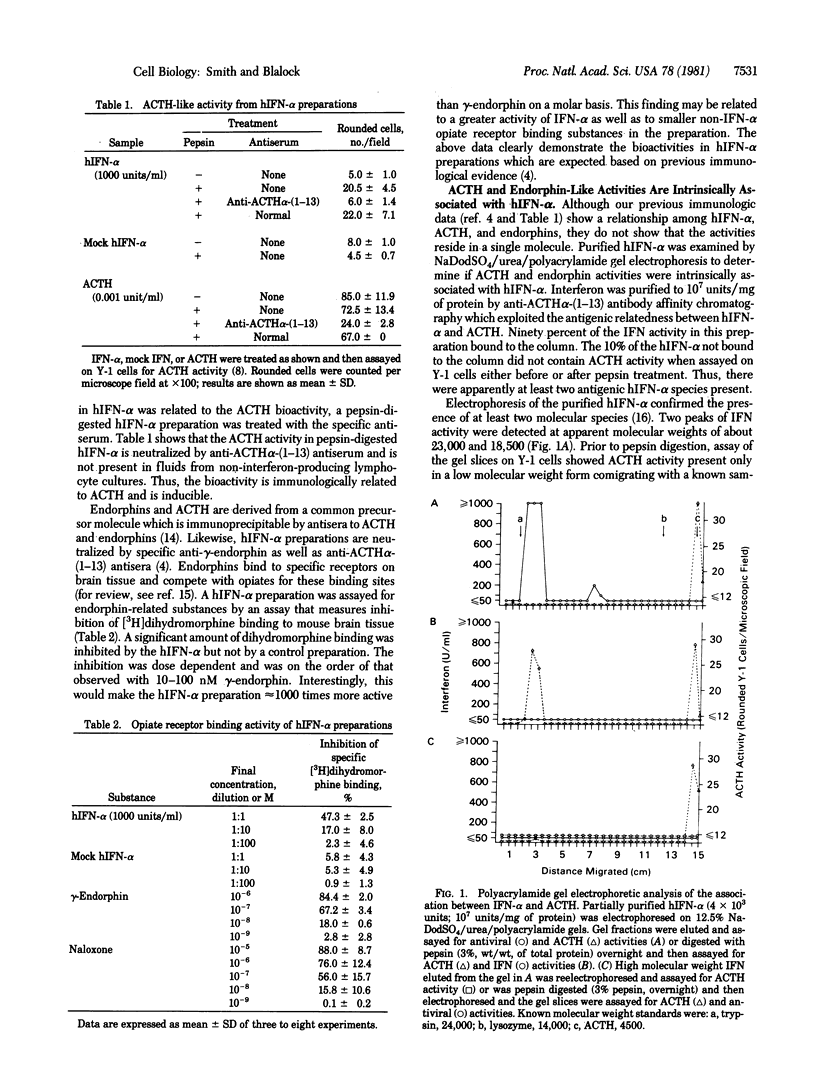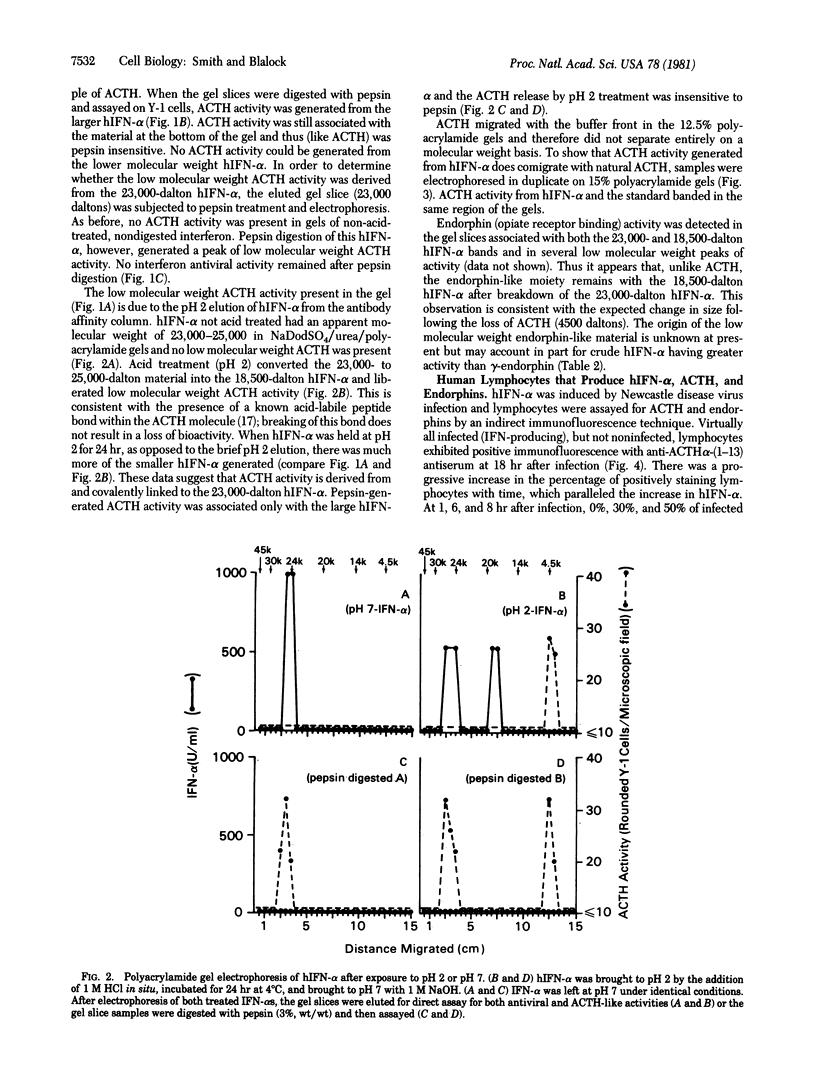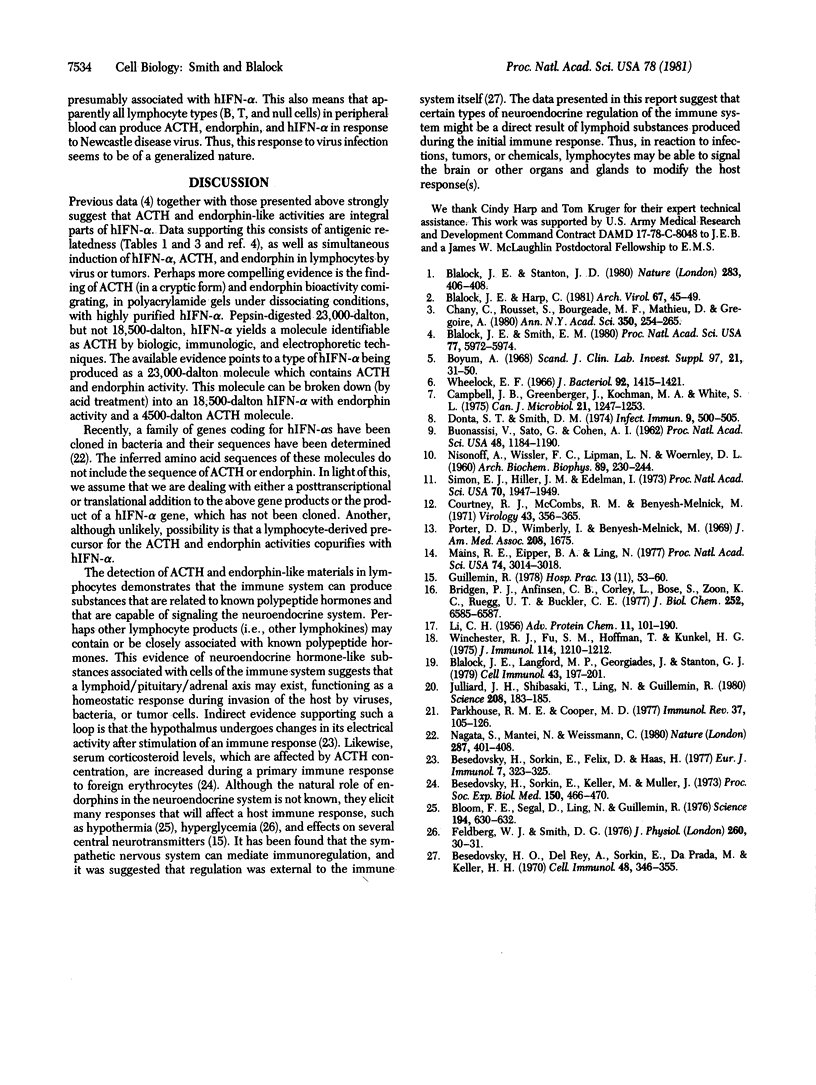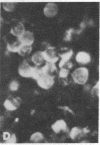Abstract
Human leukocyte interferon (hIFN-alpha) preparations contain immunologically and biologically recognizable endorphin and corticotropin-like (ACTH-like) activities. The ACTH bioactivity was demonstrable only after pepsin or acid treatment. Highly purified hIFN-alpha was composed of two molecular species of interferon (18,500 and 23,000 daltons). Endorphin activity was associated with both of these molecules. Pepsin treatment of the 23,000-dalton but not the 18,500-dalton hIFN-alpha generated ACTH activity. In acid, the 23,000-dalton hIFN-alpha broke down into the 18,500-dalton form and ACTH (4500 daltons). The ACTH derived from hIFN-alpha by pepsin digestion comigrated with a purified ACTH standard in NaDodSO4/polyacrylamide gel electrophoresis. hIFN-alpha-producing lymphocytes showed positive immunofluorescence after staining with highly specific antisera to ACTH alpha-(1-13) and gamma-endorphin. Essentially 100% of the human peripheral lymphocytes were capable of producing both ACTH and gamma-endorphin-related substances, presumably associated with hIFN-alpha. These results strongly suggest a circuit between the immune and neuroendocrine systems which involves neuroendocrine hormone-like substances, some of which are associated with hIFN-alpha
Full text
PDF




Images in this article
Selected References
These references are in PubMed. This may not be the complete list of references from this article.
- BUONASSISI V., SATO G., COHEN A. I. Hormone-producing cultures of adrenal and pituitary tumor origin. Proc Natl Acad Sci U S A. 1962 Jul 15;48:1184–1190. doi: 10.1073/pnas.48.7.1184. [DOI] [PMC free article] [PubMed] [Google Scholar]
- Besedovsky H. O., del Rey A., Sorkin E., Da Prada M., Keller H. H. Immunoregulation mediated by the sympathetic nervous system. Cell Immunol. 1979 Dec;48(2):346–355. doi: 10.1016/0008-8749(79)90129-1. [DOI] [PubMed] [Google Scholar]
- Besedovsky H., Sorkin E., Felix D., Haas H. Hypothalamic changes during the immune response. Eur J Immunol. 1977 May;7(5):323–325. doi: 10.1002/eji.1830070516. [DOI] [PubMed] [Google Scholar]
- Besedovsky H., Sorkin E., Keller M., Müller J. Changes in blood hormone levels during the immune response. Proc Soc Exp Biol Med. 1975 Nov;150(2):466–470. doi: 10.3181/00379727-150-39057. [DOI] [PubMed] [Google Scholar]
- Blalock J. E., Harp C. Interferon and adrenocorticotropic hormone induction of steroidogenesis, melanogenesis and antiviral activity. Arch Virol. 1981;67(1):45–49. doi: 10.1007/BF01314600. [DOI] [PubMed] [Google Scholar]
- Blalock J. E., Langford M. P., Georgiades J., Stanton G. J. Nonsensitized lymphocytes produce leukocyte interferon when cultured with foreign cells. Cell Immunol. 1979 Mar 1;43(1):197–201. doi: 10.1016/0008-8749(79)90163-1. [DOI] [PubMed] [Google Scholar]
- Blalock J. E., Smith E. M. Human leukocyte interferon: structural and biological relatedness to adrenocorticotropic hormone and endorphins. Proc Natl Acad Sci U S A. 1980 Oct;77(10):5972–5974. doi: 10.1073/pnas.77.10.5972. [DOI] [PMC free article] [PubMed] [Google Scholar]
- Blalock J. E., Stanton J. D. Common pathways of interferon and hormonal action. Nature. 1980 Jan 24;283(5745):406–408. doi: 10.1038/283406a0. [DOI] [PubMed] [Google Scholar]
- Bloom F., Segal D., Ling N., Guillemin R. Endorphins: profound behavioral effects in rats suggest new etiological factors in mental illness. Science. 1976 Nov 5;194(4265):630–632. doi: 10.1126/science.185694. [DOI] [PubMed] [Google Scholar]
- Bridgen P. J., Anfinsen C. B., Corley L., Bose S., Zoon K. C., Rüegg U. T., Buckler C. E. Human lymphoblastoid interferon. Large scale production and partial purification. J Biol Chem. 1977 Oct 10;252(19):6585–6587. [PubMed] [Google Scholar]
- Böyum A. Isolation of leucocytes from human blood. Further observations. Methylcellulose, dextran, and ficoll as erythrocyteaggregating agents. Scand J Clin Lab Invest Suppl. 1968;97:31–50. [PubMed] [Google Scholar]
- Campbell J. B., Grunberger T., Kochman M. A., White S. L. A microplaque reduction assay for human and mouse interferon. Can J Microbiol. 1975 Aug;21(8):1247–1253. doi: 10.1139/m75-186. [DOI] [PubMed] [Google Scholar]
- Chany C., Rousset S., Bourgeade M. F., Mathieu D., Grégoire A. Role of receptors and the cytoskeleton in reverse transformation and steroidogenesis induced by interferon. Ann N Y Acad Sci. 1980;350:254–265. doi: 10.1111/j.1749-6632.1980.tb20626.x. [DOI] [PubMed] [Google Scholar]
- Courtney R. J., McCombs R. M., Benyesh-Melnick M. Antigens specified by herpesviruses. II. Effect of arginine deprivation on the synthesis of cytoplasmic and nuclear proteins. Virology. 1971 Feb;43(2):356–365. doi: 10.1016/0042-6822(71)90308-4. [DOI] [PubMed] [Google Scholar]
- Donta S. T., Smith D. M. Stimulation of steroidogenesis in tissue culture by enterotoxigenic Escherichia coli and its neutralization by specific antiserum. Infect Immun. 1974 Mar;9(3):500–505. doi: 10.1128/iai.9.3.500-505.1974. [DOI] [PMC free article] [PubMed] [Google Scholar]
- Guillemin R. Beta-lipotropin and endorphins: implications of current knowledge. Hosp Pract. 1978 Nov;13(11):53–60. doi: 10.1080/21548331.1978.11707431. [DOI] [PubMed] [Google Scholar]
- Julliard J. H., Shibasaki T., Ling N., Guillemin R. High-molecular-weight immunoreactive beta-endorphin in extracts of human placenta is a fragment of immunoglobulin G. Science. 1980 Apr 11;208(4440):183–185. doi: 10.1126/science.6244620. [DOI] [PubMed] [Google Scholar]
- LI C. H. Hormones of the anterior pituitary gland. I. Growth and adrenocorticotropic hormones. Adv Protein Chem. 1956;11:101–190. doi: 10.1016/s0065-3233(08)60421-0. [DOI] [PubMed] [Google Scholar]
- Mains R. E., Eipper B. A., Ling N. Common precursor to corticotropins and endorphins. Proc Natl Acad Sci U S A. 1977 Jul;74(7):3014–3018. doi: 10.1073/pnas.74.7.3014. [DOI] [PMC free article] [PubMed] [Google Scholar]
- NISONOFF A., WISSLER F. C., LIPMAN L. N., WOERNLEY D. L. Separation of univalent fragments from the bivalent rabbit antibody molecule by reduction of disulfide bonds. Arch Biochem Biophys. 1960 Aug;89:230–244. doi: 10.1016/0003-9861(60)90049-7. [DOI] [PubMed] [Google Scholar]
- Nagata S., Mantei N., Weissmann C. The structure of one of the eight or more distinct chromosomal genes for human interferon-alpha. Nature. 1980 Oct 2;287(5781):401–408. doi: 10.1038/287401a0. [DOI] [PubMed] [Google Scholar]
- Parkhouse R. M., Cooper M. D. A model for the differentiation of B lymphocytes with implications for the biological role of IgD. Immunol Rev. 1977;37:105–126. doi: 10.1111/j.1600-065x.1977.tb00247.x. [DOI] [PubMed] [Google Scholar]
- Porter D. D., Wimberly I., Benyesh-Melnick M. Prevalence of antibodies to EB virus and other herpesviruses. JAMA. 1969 Jun 2;208(9):1675–1679. [PubMed] [Google Scholar]
- Simon E. J., Hiller J. M., Edelman I. Stereospecific binding of the potent narcotic analgesic (3H) Etorphine to rat-brain homogenate. Proc Natl Acad Sci U S A. 1973 Jul;70(7):1947–1949. doi: 10.1073/pnas.70.7.1947. [DOI] [PMC free article] [PubMed] [Google Scholar]
- Wheelock E. F. Virus replication and high-titered interferon production in human leukocyte cultures inoculated with Newcastle disease virus. J Bacteriol. 1966 Nov;92(5):1415–1421. doi: 10.1128/jb.92.5.1415-1421.1966. [DOI] [PMC free article] [PubMed] [Google Scholar]
- Winchester R. J., Fu S. M., Hoffman T., Kunkel H. G. IgG on lymphocyte surfaces; technical problems and the significance of a third cell population. J Immunol. 1975 Apr;114(4):1210–1212. [PubMed] [Google Scholar]






